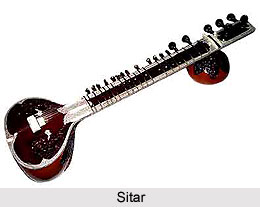 There are various techniques related to the sitar. Indian Sitar is a string musical instrument said to have been introduced in India in the thirteenth century by Amir Khusrau. The techniques of melodic execution on the Sitar can be divided into two groupings:
There are various techniques related to the sitar. Indian Sitar is a string musical instrument said to have been introduced in India in the thirteenth century by Amir Khusrau. The techniques of melodic execution on the Sitar can be divided into two groupings:
Fretwork: In it the fingers of the left hand move from fret to fret.
Deflection: Here the fingers are static on one fret and tonal transition is achieved by pulling the string without movement between the frets.
Fretwork techniques belong to the traditional Sitar idiom that developed before the Sitar gained much strength to audibly render an array of svaras performed under a single stroke. The deflection techniques developed along with structural improvements in the sitara and their maturation enabled the evolution of the vocalized idiom.
Techniques of Fretwork
In addition to the straight forward execution Fretwork techniques are of mainly two types Krintana and Ghasita.
Krintana: It requires the movement of two fingers over the frets. The first svara performed with a right-hand stroke supporting one left-hand finger resting on the fret-board. The subsequent svaras of the phrase are executed with the second finger beating the appropriate fret in a hammering motion, but without further right-hand stroke support. With this technique, a phrase of up to four svaras can be executed. This technique is unique to the sitara, and originated even before the sitara acquired sympathetic strings, and has remained an essential feature of tantakara ang of the sitara.
Ghasita: It executes a phrase, usually flat-out and unidirectional, by dragging the left hand finger along the fret-board over at least half an octave under the impact of a single stroke. This is accompanied by feather-touch left-hand pressure over the string, so that the resultant glide delivers an aural impression of a fretless instrument. It is common for the ghasita to span a full octave unidirectional, as it can do on the Rudra Veena. The ghasita on the Sitara is inspired by the suta technique practiced on the Rudra Veena which, in turn, is inspired by the vocal idiom of Dhrupad music.
Techniques of Deflection
There are three principal deflection techniques (a) Minda (b) Murki and (c) Gamaka.
Minda: It is a simple execution of a phrase by pulling the string from a single fret, and executing a phrase under the impact of a single stroke. Three-svara mindas were common in sitara music up to the 1930s. The contemporary Sitara, because of enhanced sustaining ability, can deliver a five-svara minda.
Murki: It is a special type of minda, where the phrase involves a wrap-around execution with a jerky motion. The contemporary sitara can support a murki of up to eight svaras under a single stroke.
Gamaka: This creates a pulsating or quivering effect, a magnified vibrato by repeatedly attacking a svara from a fret at a lower pitch. The gamaka is generally used for distances of upto two, occasionally three, svaras.




















